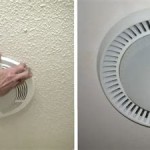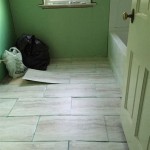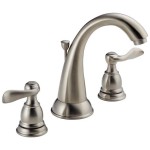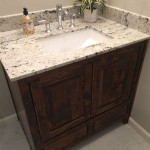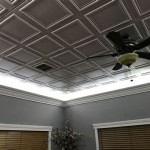Does a Bathroom Vanity Need Backsplash? Examining the Purposes and Considerations
The question of whether a bathroom vanity requires a backsplash is a common one during bathroom renovation or construction projects. While not strictly mandated like plumbing or electrical codes, the presence or absence of a backsplash significantly impacts both the functionality and aesthetics of the bathroom space. A backsplash is the vertical extension of the vanity countertop, typically made of tile, stone, or other water-resistant materials, that protects the wall behind the sink from water splashes and other potential damage. Making an informed decision regarding backsplash installation involves carefully weighing the advantages, disadvantages, and alternative options.
The primary function of a backsplash is to safeguard the wall behind the vanity from water damage. Water from handwashing, teeth brushing, and general sink use can easily splash onto the wall. Over time, this constant exposure to moisture can lead to several problems, including mold and mildew growth, peeling paint, and even structural damage to the drywall. Backsplashes create a barrier that prevents water from directly contacting the wall, effectively mitigating these risks. Furthermore, backsplashes can protect the wall from toothpaste splatters, soap residue, and other stains that can be difficult to remove.
Beyond protection, a backsplash contributes significantly to the overall aesthetic of the bathroom. It provides an opportunity to introduce color, texture, and pattern, enhancing the visual appeal of the vanity area. The material, color, and style of the backsplash can be chosen to complement the vanity, countertop, and overall bathroom design. A well-chosen backsplash can serve as a focal point, adding a touch of sophistication and personality to the space.
Key Point 1: The Practical Benefits of a Bathroom Vanity Backsplash
The most compelling reason to install a bathroom vanity backsplash is its ability to protect the wall from water damage. As previously mentioned, moisture accumulation can lead to a host of problems, including mold and mildew growth. Mold and mildew not only pose health risks but also can damage the structural integrity of the wall. Removing mold and repairing water-damaged drywall can be costly and time-consuming. A backsplash acts as a preventative measure, minimizing the risk of these issues.
In addition to preventing water damage, a backsplash simplifies cleaning and maintenance. Walls behind vanities are prone to splatters and spills, including toothpaste, soap, and makeup. These substances can be difficult to remove from painted or wallpapered surfaces, potentially leaving stains or damaging the finish. A backsplash, especially one made of tile or stone, is typically easier to clean and maintain, requiring only occasional wiping with a damp cloth.
Another practical benefit is the ability to conceal imperfections in the wall surface. Walls are not always perfectly smooth or even, and minor imperfections can be visible behind a vanity. A backsplash can cover up these imperfections, creating a cleaner and more polished look. This is particularly useful in older bathrooms where the walls may have experienced some wear and tear over time.
Furthermore, a small backsplash can hide the gap between the vanity top and the wall. This gap is often sealed with caulk, but even with careful application, the caulk can crack or discolor over time. A backsplash provides a more permanent and aesthetically pleasing solution to concealing this gap, preventing water from seeping behind the vanity.
Key Point 2: Aesthetic Considerations and Design Implications
Beyond its practical benefits, a backsplash plays a crucial role in the overall aesthetic of the bathroom. It provides an opportunity to introduce design elements that complement the vanity, countertop, and other bathroom fixtures. The choice of backsplash material, color, pattern, and texture can significantly impact the visual appeal of the space.
Tile is the most common material for backsplashes, offering a wide variety of styles, colors, and sizes. Ceramic tile is a popular choice due to its durability, affordability, and ease of maintenance. Porcelain tile is even more durable and water-resistant, making it a suitable option for high-moisture environments. Glass tile can add a touch of elegance and sophistication, while natural stone tile provides a more rustic or organic look.
The color of the backsplash should be chosen to complement the other elements in the bathroom. A neutral color backsplash, such as white, beige, or gray, can be a versatile option that works well with a variety of design styles. A bolder color or pattern can be used to create a focal point or add visual interest to the space. Consider the existing color scheme and choose a backsplash that enhances the overall aesthetic.
The size and shape of the backsplash can also impact the overall design. A full backsplash, extending from the countertop to the bottom of the mirror or light fixture, can create a dramatic effect. A shorter backsplash, typically 4 to 6 inches in height, provides adequate protection while maintaining a more minimalist look. The shape of the tiles can also be varied, such as subway tiles, mosaic tiles, or geometric patterns, to create different visual effects.
Lighting also plays a role in how the backsplash is perceived. Under-cabinet lighting can highlight the texture and color of the backsplash, adding depth and dimension to the space. Proper lighting can also enhance the overall ambiance of the bathroom, creating a more inviting and relaxing atmosphere.
Key Point 3: Alternatives to a Traditional Backsplash and When They Might Be Appropriate
While a traditional backsplash is a common and effective solution, there are alternative options to consider. These alternatives may be suitable for bathrooms where a minimalist aesthetic is desired, or where a traditional backsplash is not feasible due to design constraints.
One alternative is to use a highly water-resistant paint specifically formulated for bathrooms. These paints are designed to withstand moisture and prevent mold and mildew growth. They often have a smooth, semi-gloss, or gloss finish that is easy to clean. While water-resistant paint can provide some protection, it may not be as effective as a traditional backsplash in preventing water damage over the long term, especially in areas with heavy water exposure.
Another option is to install a solid surface countertop with an integrated backsplash. This creates a seamless and cohesive look, eliminating the need for separate tiles or materials. Solid surface countertops are typically made of materials such as acrylic or polyester and are non-porous, making them resistant to water damage and staining. This option is often more expensive than a traditional backsplash but can provide a sleek and modern aesthetic.
A third alternative is to use a decorative panel or wainscoting behind the vanity. This can add texture and visual interest to the space while providing some protection from water damage. Decorative panels are typically made of wood, MDF, or PVC and can be painted or stained to match the vanity or other bathroom fixtures. Wainscoting is a type of decorative paneling that covers the lower portion of the wall, providing a classic and elegant look.
The decision to forego a traditional backsplash may be appropriate in certain situations. For example, if the vanity is located in a powder room that is used primarily for handwashing, the risk of water damage may be lower. In a modern or minimalist bathroom design, a backsplash may be perceived as unnecessary or visually disruptive. However, it is important to carefully consider the potential risks and benefits before deciding to forego a backsplash entirely.
Ultimately, the decision of whether or not to install a bathroom vanity backsplash is a personal one. It should be based on a combination of factors, including the budget, the desired aesthetic, and the level of protection required. By carefully considering these factors, homeowners can make an informed decision that ensures both the functionality and beauty of their bathroom space.
Backsplash Advice For Your Bathroom Would You Tile The Side Walls Too Designed

Do Bathroom Vanities Need A Backsplash

Backsplash Advice For Your Bathroom Would You Tile The Side Walls Too Designed

Backsplash Advice For Your Bathroom Would You Tile The Side Walls Too Designed

Do You Need A Backsplash For Your Bathroom Vanity Diamond Kitchen Bath
Backsplash Advice For Your Bathroom Would You Tile The Side Walls Too Designed

Do You Really Need A Bathroom Vanity Backsplash Hunker Trends Design

Side Splash Or No

Backsplash Advice For Your Bathroom Would You Tile The Side Walls Too Designed

A Better Alternative To 4 Inch Tall Backsplash
Related Posts
